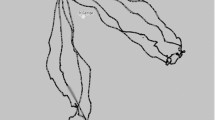Abstract
Movement of animals in relation to objects in their environment is important in many areas of ecology and wildlife conservation. Tools for analysis of movement data, however, still remain rather limited. In previous work, we developed nonlinear regression models for movement in relation to a single landscape feature. Here we greatly expand these previous models by using artificial neural networks. The new models add substantial flexibility and capabilities, including the ability to incorporate multiple factors and covariates. We devise a likelihood-based model fitting procedure that utilizes genetic algorithms and demonstrate the approach with movement data for red diamond rattlesnakes. The proposed methodology can be useful for global positioning system tracking data that are becoming more common in studies of animal movement behavior.
Similar content being viewed by others
References
Batschelet E (1981) Circular statistics in biology. Academic, New York
Bishop CM (2005) Neural networks for pattern recognition. Oxford University Press, New York
Brillinger DR, Preisler HK, Ager AA, Kie JG (2004) An exploratory data analysis (EDA) of the paths of moving animals. J Stat Plan Inference 122: 43–63
Burnham KP, Anderson D.R. (2002) Model selection and multimodel inference, 2nd edn. Springer, New York
Christ A, Ver Hoef JM, Zimmerman DL (2008) An animal movement model incorporating home range and habitat selection. Environ Ecol Stat 15: 27–38
Dalziel BD, Morales JM, Fryxell JM (2008) Fitting probability distributions to animal movement trajectories: using artificial neural networks to link distance, resources, and memory. Am Nat 172: 248–258
Eiben AE, Smith JE (2003) Introduction to evolutionary computing. Springer, New York
Enquist M, Ghirlanda S (2005) Neural networks and animal behavior. Princeton Univesity Press, Princeton
Environmental Systems Reseach Institute Inc: (1999) ArcView 3.2 with spatial analyst extension. Redlands, CA
Forester JD, Im HK, Rathouz PJ (2009) Accounting for animal movement in estimation of resource selection functions: sampling and data analysis. Ecology 90: 3554–3565
Hassoun MH (1995) Fundamentals of artificial neural network. MIT Press, Cambridge
Holland JH (1992) Adaptation in natural and artificial systems. MIT Press, Cambridge
Hooten MB, Johnson DS, Lowry JH (2010) Agent-based inference for animal movement and selection. J Agric Biol Environ Stat (to appear)
Jander R (1975) Ecological aspects of spatial orientation. Annu Rev Ecol Syst 6: 171–188
Johnson DS, Thomas DL, Ver Hoef JM, Christ A (2008) A general framework for the analysis of animal resource selection from telemetry data. Biometrics 64: 968–976
Kareiva PM, Shigesada N (1983) Analyzing insect movement as a correlated random walk. Oecologia 56: 234–238
Krebs JR, Davies NB (1993) An introduction to behavioral ecology, 3rd edn. Blackwell Science Ltd, Oxford
Lima SL, Zollner PA (1996) Towards a behavioral ecology of ecological landscapes. Trends Ecol Evol 11: 131–135
Mardia KV, Jupp PE (2000) Directional statistics. Wiley, New York
Mitchell M (1996) An introduction to genetic algorithms. MIT Press, Cambridge
Morales JM, Fortin D, Frair JL, Merrill EH (2005) Adaptive models for large herbivore movements in heterogeneous landscapes. Landsc Ecol 20: 301–316
Patterson TA, Thomas L, Wilcox C, Ovaskainen O, Matthiopoulos J (2008) State-based models of individual animal movement. Trends Ecol Evol 23: 87–94
R Development Core Team (2008) R: a language and environment for statistical computing. R foundation for statistical computing, Vienna, Austria. ISBN 3-900051-07-0
Reed RD, Marks RJI (1999) Neural smithing. MIT Press, Cambridge
Strand E, Huse G, Giske J (2002) Artificial evolution of life history and behavior. Am Nat 159: 624–644
Tracey JA (2000) Movement of red diamond rattlesnakes (Crotalus ruber) in heterogeneous landscapes in coastal southern california. Master’s thesis, University of California, San Diego
Tracey JA (2006) Individual-based modeling as a tool for conserving connectivity. In: Crooks KR, Sanjayan M (eds) Connectivity conservation. Cambridge University Press, Cambridge
Tracey JA, Zhu J, Crooks K (2005) A set of nonlinear regression models for animal movement in response to a single landscape feature. J Agric Biol Environ Stat 10: 1–18
Turchin P. (1998) Quantitative analysis of movement. Sinauer Associates, Sunderland
Van Vuren D (1998) Mammilian dispersal and reserve design. In: Caro T (eds) Behavioral ecology and conservation biology. New York, Oxford
Author information
Authors and Affiliations
Corresponding author
Rights and permissions
About this article
Cite this article
Tracey, J.A., Zhu, J. & Crooks, K.R. Modeling and inference of animal movement using artificial neural networks. Environ Ecol Stat 18, 393–410 (2011). https://doi.org/10.1007/s10651-010-0138-8
Received:
Revised:
Published:
Issue Date:
DOI: https://doi.org/10.1007/s10651-010-0138-8




